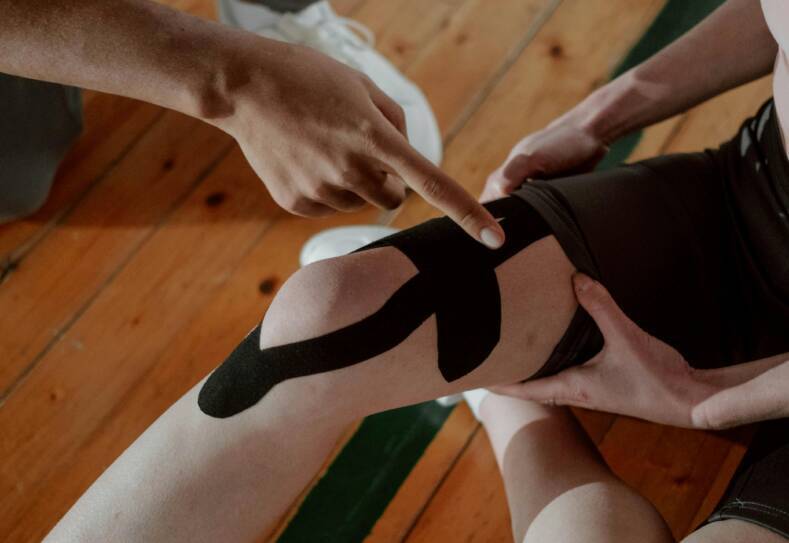Knee injuries are a common concern for runners, ranging from occasional discomfort to serious conditions that can sideline an athlete from their training regimen. The repetitive impact and stress of running can lead to what’s often referred to as ‘runner’s knee,’ or in medical terms, patellofemoral pain syndrome (PFPS). This condition manifests as pain around the patella, usually at the front of the knee, where the symptoms can be exacerbated by activity and relieved by rest. Aside from PFPS, runners may experience various symptoms such as swelling, a popping sensation, stiffness, or a feeling as though the knee is locked, indicating different potential injuries like meniscus tears.
Correctly identifying the symptoms of knee injuries is crucial to addressing them effectively. Pain can vary greatly in its nature; it might be a sharp pain that occurs suddenly and intensely or a dull ache that grows over time. Swelling is another telltale sign, and it can occur throughout the knee or be localized to a specific area. Some runners report a grinding or clicking sound when the knee moves, which can indicate complications with the kneecap’s movement.
The course of treatment for knee injuries typically involves a period of rest, as continuous running can worsen the condition. Ice, compression, and elevation are often recommended to reduce pain and swelling in the initial stages. Rehabilitation exercises that focus on strengthening and stretching the muscles supporting the knee are also critical in recovery and preventing future injuries. As running is a high-impact exercise, understanding these symptoms and appropriate interventions allows runners to maintain their health and continue to enjoy the sport.
Common Running Knee Injuries
Running commonly leads to knee injuries resulting from overuse, structural defects, or improper movement patterns. These conditions often exhibit similar symptoms, such as pain and discomfort around the knee area.
Runner’s Knee (Patellofemoral Pain Syndrome)
Runner’s Knee, or Patellofemoral Pain Syndrome (PFPS), is characterized by pain around or behind the kneecap. It is commonly caused by repeated stress on the knee, which can be a result of overuse, weak thigh muscles, or misalignment.
Iliotibial Band Syndrome
Iliotibial Band Syndrome manifests as pain on the outside of the knee due to inflammation of the Iliotibial band, a tendon that runs along the side of the leg. It often occurs when the band becomes tight or when there is friction between the band and the knee joint.
Patellar Tendinitis
Patellar Tendinitis, also known as Jumper’s Knee, involves inflammation of the patellar tendon, which connects the kneecap to the shinbone. This condition is often the result of repetitive jumping or running activities that strain the tendon.
Chondromalacia Patella
Chondromalacia Patella refers to the softening and breakdown of the cartilage on the underside of the kneecap, leading to pain and inflammation. It can occur from improper kneecap movement or alignment, excessive running, or injury to the kneecap.
Symptoms of Knee Injuries
Knee injuries from running are often marked by distinct symptoms that can indicate the type of injury and severity. Understanding these symptoms is vital for identifying the issue and seeking appropriate treatment.
Pain and Tenderness
Runners may experience pain in the front of the knee or around the kneecap, which may worsen with activity. Tenderness along the joint line can also be a sign of an underlying knee injury which needs to be evaluated by a healthcare professional.
Swelling and Inflammation
Swelling can occur as a natural response to injury as the body tries to protect the affected area. Inflammation can lead to additional stiffness and pain, making it uncomfortable to move the knee through its full range of motion.
Popping or Grinding Noises
A sensation of popping or grinding, also known as crepitus, may be felt under the kneecap while moving. This can be a result of the surfaces within the knee joint rubbing irregularly against each other.
Instability and Weakness
Feelings of instability or giving way might indicate damage to the knee’s structures, making it feel as if the knee cannot support body weight adequately. Weakness can also be a sign that injury may be affecting the knee’s ability to function correctly.
Diagnosis of Knee Injuries
When a patient presents with knee pain from running, a healthcare professional conducts a comprehensive diagnosis which typically begins with a physical exam and may include various imaging tests if necessary. The accuracy of the diagnosis is crucial to ensure effective treatment and recovery.
Physical Exam
During the physical exam, the doctor assesses the knee for signs of injury, focusing on pain, swelling, tenderness, and range of motion. Palpation—the process of pressing on different parts of the knee—is used to identify specific areas of discomfort or injury. The doctor may also perform mobility tests to evaluate the knee’s function, including the patellar tracking assessment to look for signs of patellofemoral pain syndrome.
Imaging Tests
To complement the physical exam, doctors often turn to imaging tests for a clearer picture of the knee’s structure:
- X-rays: These are typically the first imaging test ordered to rule out bone fractures and to assess for joint space and any potential misalignments.
- Magnetic Resonance Imaging (MRI): An MRI is more detailed and can reveal soft tissue injuries such as ligament tears, meniscus injuries, and muscle strains.
- Computed Tomography (CT) Scan: Though less common for knee injuries, a CT scan might be used to provide a better view of the bone structure around the knee.
Specialized Examination Techniques
In some cases, healthcare providers may use specialized techniques to diagnose knee injuries:
- Gait Analysis: By observing the patient’s walking pattern, doctors can sometimes identify biomechanical issues contributing to knee pain.
- Arthroscopy: Although it is a surgical procedure, it can be used for diagnosis when imaging doesn’t provide a conclusive assessment, allowing the doctor to visually inspect the inside of the knee joint.
Underlying Causes and Risk Factors
Knee injuries from running are frequently multifactorial, arising from a complex interplay between anatomical variations, strenuous activity levels, inappropriate footwear, and existing health conditions. Understanding these factors is pivotal for prevention and management.
Anatomical Variations
Individuals with malalignment of the hip, femur, or thigh bone may experience increased stress on the knee joint. Flat feet or arch abnormalities can also alter lower limb biomechanics, leading to knee pain. These anatomical deviations can predispose runners to injuries such as patellofemoral pain syndrome, commonly referred to as runner’s knee.
Overuse and Activity Level
Overuse is a primary risk factor for running-related knee injuries. It typically occurs when a runner significantly increases their mileage or intensity without adequate rest. Repeating the same high-impact movements can place excessive strain on the knee, especially when involving activities such as jogging, mountaineering, or repetitive squatting.
Footwear and Surface
Running shoes play a vital role in cushioning and stabilizing the feet during motion. Wearing shoes with insufficient support or wearing out of footwear can contribute to injuries. Additionally, the running surface has an impact; hard or uneven surfaces may increase the risk of knee pain.
- Ideal Running Shoe Characteristics:
- Adequate cushioning
- Proper arch support
- Fit tailored to individual foot shape
Other Health Conditions
Being overweight imposes additional force on the knee joints, possibly exacerbating any susceptibility to injury. Furthermore, pre-existing conditions like arthritis can weaken the knee’s structure, making it more prone to injury during running. It’s crucial for runners with existing health issues to take proactive measures, like strength training and appropriate rest, to mitigate potential risks.
Treatment and Management Approaches
Effective treatment and management of knee injuries in runners involve a multi-faceted approach that can range from self-care techniques to medical interventions. The following subsections outline the common methodologies applied to address running-related knee injuries.
RICE Method
The RICE method is a widely recommended initial treatment for acute knee injuries. It stands for:
- Rest: Ceasing activities that increase knee pain, which allows for recovery.
- Ice: Applying ice to the knee to reduce swelling and pain.
- Compression: Using elastic bandages or sleeves to apply pressure can help minimize inflammation.
- Elevation: Keeping the injured knee raised above heart level to decrease swelling.
Medication and Pain Relievers
Over-the-counter NSAIDs (non-steroidal anti-inflammatory drugs), such as ibuprofen and naproxen, are commonly used to alleviate pain and reduce inflammation. These medications should be taken as directed to avoid potential side effects.
Physical Therapy and Exercises
Physical therapy is a critical component for rehabilitation and involves:
- Targeted exercises to strengthen the muscles around the knee
- Techniques to improve flexibility and range of motion
- Instruction on proper running form to prevent re-injury
Engaging in a structured physical therapy program is often key to a runner’s recovery and return to sport.
Surgery and Invasive Procedures
Surgery may be necessary for severe knee injuries that do not respond to conservative treatments. It is typically reserved for:
- Repairing damaged structures within the knee
- Addressing injuries that compromise joint stability
Post-surgery, rehabilitation will be crucial to regain strength and functionality.
Prevention and Precautionary Measures
Minimizing the risk of running knee injuries involves a comprehensive approach that includes proper warm-up routines, refining running techniques, utilizing supportive gear, and paying attention to lifestyle and dietary habits. Adhering to these practices may significantly reduce the incidence of knee-related problems for runners.
Proper Warming Up and Cooling Down
Before starting a run, individuals should engage in dynamic stretching exercises to prepare their muscles for the activity. This can include leg swings, lunges, and gentle jogging. Post-run, it is crucial to cool down with static stretches that target the quadriceps, hamstrings, and calves to aid in recovery and reduce tightness.
- Warm-up exercises: Leg swings, high knees, lunges
- Cool-down stretches: Quadriceps stretch, hamstring stretch, calf stretch
Appropriate Running Technique
Maintaining a proper running technique reduces unnecessary strain on the knees. Runners should focus on keeping their knees aligned with their feet and avoid overstriding. They should aim for a mid-foot strike rather than landing on the heels and incorporate core strengthening exercises to improve stability and balance.
- Running form tips: Knee-foot alignment, mid-foot strike, core engagement
Supportive Gear and Orthotics
Using the right gear is essential for knee injury prevention. Runners should use shoes with adequate arch support and consider shoe inserts or orthotics if necessary, to correct any imbalances. A knee brace may provide additional support for those with a history of knee pain, while also encouraging proper knee alignment during runs.
- Gear to consider: Quality running shoes, custom orthotics, knee brace
Lifestyle and Dietary Considerations
Overall well-being contributes to injury prevention. Runners should integrate rest days into their training to allow their bodies to recover. A balanced diet rich in anti-inflammatory foods and calcium promotes muscle and bone health. Staying hydrated and maintaining a healthy weight are also important to reduce the load and impact on the knee joints.
- Key lifestyle points: Adequate rest, balanced nutrition, weight management
Recovery and Long-Term Care
Recovery from running knee injuries requires a structured approach that often includes rehabilitation programs, specific exercises aimed at strengthening and flexibility, as well as lifestyle changes. Careful monitoring of progress and any setbacks is essential to ensure a safe return to running.
Rehabilitation Programs
Rehabilitation programs are tailored to the individual’s specific needs and the particular knee injury. These programs often start with pain management strategies before proceeding to exercises. Physical therapists may introduce low-impact activities which can help maintain cardiovascular fitness without putting excessive stress on the knee.
Strengthening and Flexibility Routines
Strengthening exercises target muscles surrounding the knee, particularly the quadriceps and hamstrings, which support the patella or kneecap. This often includes:
- Quad sets: tighten the muscle on the top of the thigh to press the knee flat down.
- Straight leg raises: lifting the leg while it’s straight to strengthen the quadriceps.
To complement strengthening, flexibility exercises enhance the range of motion. These might involve:
- Hamstring stretches
- Calf stretches
Lifestyle Modifications
One’s lifestyle may require adjustments, such as:
- Reducing activities that put excessive stress on the knees.
- Incorporating rest days into exercise routines.
- Choosing footwear that provides proper support during physical activity.
Monitoring Progress and Setbacks
It is crucial for individuals to monitor their recovery, noting improvements and any pain experienced during exercises. This can involve keeping a log or journal to track:
- Exercise performance
- Pain levels
- Functional improvements
A careful and patient approach to recovery and long-term care can significantly improve the chances of returning to running without recurring knee problems.








